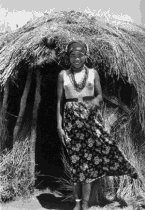
N!AI, BUSHMANNIN TYTÄR
 Dokumenttielokuvaa N!Ai, bushmannin tytär (N!Ai: The Story of a !Kung Woman) kuvattiin yli 27 vuoden ajan, 1950-luvulta vuoteen 1978. Dokumentti seuraa namibialaisen bushmanniperheen tyttären kasvua ja kuvaa samalla kaikkien bushmannien elämän muuttumista 30 vuoden aikana. Elokuva tarjoaa harvinaislaatuisen katsauksen perinteiseen kulttuuriin, joka on nopeasti katoamassa. Se tavoittaa heimon koko elämän: arjen ja juhlan, uhat ja mahdollisuudet.
Dokumenttielokuvaa N!Ai, bushmannin tytär (N!Ai: The Story of a !Kung Woman) kuvattiin yli 27 vuoden ajan, 1950-luvulta vuoteen 1978. Dokumentti seuraa namibialaisen bushmanniperheen tyttären kasvua ja kuvaa samalla kaikkien bushmannien elämän muuttumista 30 vuoden aikana. Elokuva tarjoaa harvinaislaatuisen katsauksen perinteiseen kulttuuriin, joka on nopeasti katoamassa. Se tavoittaa heimon koko elämän: arjen ja juhlan, uhat ja mahdollisuudet.
Noin 35-vuotias N!Ai kertoo meille oman tarinansa. Kertomusta täydennetään katkelmilla, jotka kuvattiin 1950-luvulla hänen ollessaan nuori tyttö ja nuori vaimo. "Ennen valkoisten ihmisten saapumista elimme niin kuin sydämemme sanoi", muistelee N!Ai ja kuvailee lapsuusaikaansa sellaisena kuin hän sen muistaa:
Pienen yhteisön jäsenet vaelsivat vapaina metsästäjinä ja keräilijöinä laajoilla autiomaa-alueilla. Riistaa ja syötäviä kasveja riitti, ja ruoka jaettiin sulassa sovussa. Vuoteen 1978 mennessä elämä on muuttunut: 800 bushmannia on sullottu alueelle, joka on kooltaan vain puolet heidän aiemmasta asuinalueestaan. Ruuasta ja vedestä on pulaa, tuberkuloosi on yleinen sairaus ja Etelä-Afrikan armeija värvää bushmanneja taisteluihin. Myös raha ja asioiden salailu aiheuttavat ongelmia - ironista kyllä, osa N!Ain ongelmista johtuu rahasta, jonka hän on hankkinut työskentelemällä valkoisten valokuvaajien ja elokuvantekijöiden kanssa.
N!Ai, bushmannin tytär on mestarillinen klassikko, joka on voittanut useita palkintoja.
- Ohjaaja: John Marshall
- Tuotanto: Documentary Educational Resources , USA, 1980
In English In English In English
N!AI: THE STORY OF A !KUNG WOMAN
 This film provides a broad overview of !Kung life, both past and present, and an intimate portrait of N!ai, a !Kung woman in her mid-thirties in 1978. N!ai tells her own story, and in so doing the story of change in !Kung life during the past thirty years. Footage shot throughout the 1950s as well as footage from 1978 is used to complement her narrative.
This film provides a broad overview of !Kung life, both past and present, and an intimate portrait of N!ai, a !Kung woman in her mid-thirties in 1978. N!ai tells her own story, and in so doing the story of change in !Kung life during the past thirty years. Footage shot throughout the 1950s as well as footage from 1978 is used to complement her narrative.
Before the white people came we did what our hearts wanted, N!ai recalls, describing the life she remembers as a child: following her mother to pick berries, roots, and nuts as the seasons changed; the division of giraffe meat; the kinds of rain; her resistance to her marriage to /Gunda at the age of eight; and her changing feelings about her husband when he became a healer. As N!ai speaks, the film presents scenes from the 1950s that show her as a young girl and a young wife. The film then moves to a scene in 1978: Tshum!kwi, the South African government reservation, where land is restricted, game and plant foods are scarce, money and secrecy have become problems, tuberculosis is prevalent, and the South African army is recruiting !Kung to fight the guerilla forces of the South West Africa People's Army, or SWAPO. N!ai picks up a stringed instru-ment and composes a song describing the tensions of reservation life, singing, "death is dancing me ragged." Ironically, some of N!ai's problems stem from the wealth she has acquired through her work with the Marshall film crew, as well as work from numerous other white photographers and filmmakers who have found her beautiful. The romanticization of the !Kung proceeds: we see clips of filming "7he Gods Must Be Crazy, " a commercial movie which has broken box-office records in South Africa and abroad.
N!ai, 7he Story of a !Kung Woman has won a number of major awards since it was originally aired. The uniqueness of the film may lie in its tight integration of ethnography and history. At the same time, as the film portrays the changes in !Kung society over three decades, it never lose@ sight of the individual, N!ai. Through N!ai the story of the !Kung becomes more accessible, more personal, and ultimately more poignant. Filmmaker, John Marshall is currently working on a 3 hour trilogy for television that will tell the complete story of his life and work with the !Kung Bushmen of the Kalahari from 1950 to 2000. It should be ready for broadcast in late fall 2000.
- Director: John Marshall
- Production: Documentary Educational Resources , USA, 1980

Päivitys: 28.6.2000 U.E.